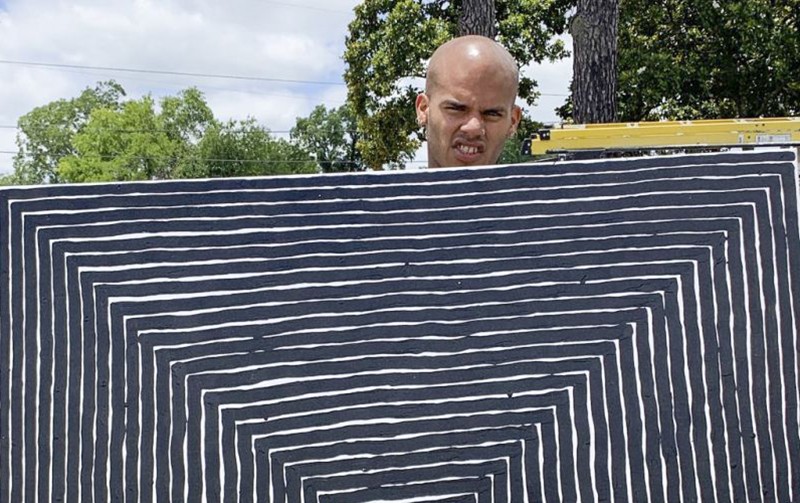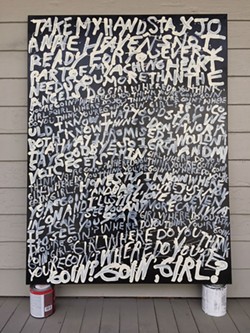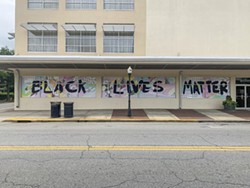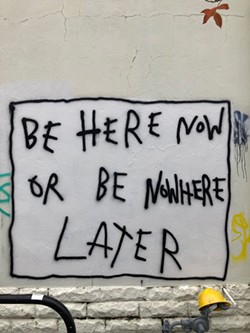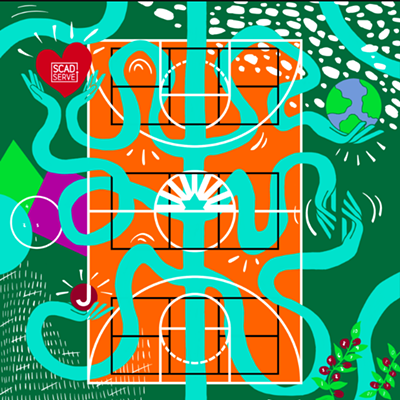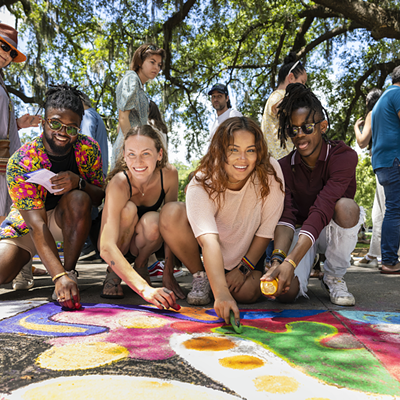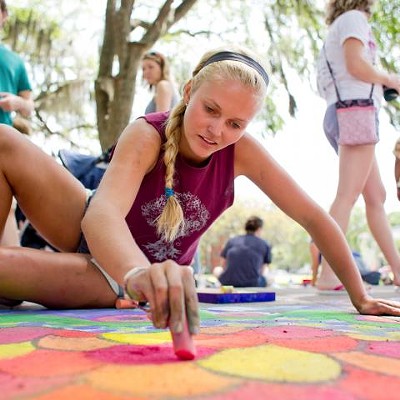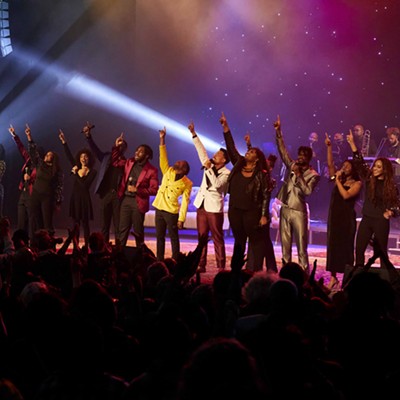TAYLER AYERS is everywhere.
No, seriously—you’ve probably seen his TEA tag around town, or seen someone wearing his merch, or seen someone repost one of his pieces on Instagram.
He’s designed a label for Two Tides, and he recently worked on a Black Lives Matter mural in collaboration with Will Penny for SCAD.
It might seem like a lot of work to be everywhere, but for Ayers, it’s just part of the deal.
Growing up, Ayers played tournament tennis and was not interested in art until a trip to Italy allowed him the chance to see a da Vinci sculpture in town. He came to SCAD in 2015 and graduated last year.
Ayers’ work is primarily comprised of black and white text, and his goal is to produce work that’s relatable.
We talked with Ayers last week.
How has your creativity changed since you came to Savannah?
When I was just starting out, I was into the 20th century art history classes. That was great to open my mind up to different types of art and the conversations that art can create—and only that can be created by art.
I’m a huge Basquiat fan, a huge Keith Haring fan, a huge graffiti fan in general. Everywhere I go, I have a pen on me. I was tagging desks, sides of businesses, and I got obsessed with it. I’m going to mark on everything and make Savannah my city.
I started selling a little bit of work, posting a lot of stuff online. I was a fibers major at SCAD, but no one really knew how to critique my work because it was not necessarily what you’d find from a fibers major. I think that made it hard for me academically, not in a sense where I was a bad student but I just felt a little displaced. But that made me hone in on what I was really good at. It helped that I was a sophomore, but I was 22 instead of 19—I already had a pretty good idea of who I was, so I started to show a strong sense of identity and individuality in my work.
I’d been selling work, but I didn’t look at it from a business standpoint. I was like, “Oh, I have money I can spend on shit.” But [I learned] the power of social media and interacting with different types of people. When I was about to graduate, I was like, “Well, I know how to make art, I sell it, but I’m not in the business headspace quite yet. But I also don’t want to go work for anyone because I don’t have that personality.”
That’s when I started working at PERC. When I was growing up, I was always playing tennis so I never got the chance to work a service or retail job, so I was always reselling shoes at school. I camped out for shoes and resold them. I was like, “If I can’t work a 9-to-5, I can just camp out for 11 hours and flip shoes with a 400% increase.”
I didn’t really know how to tie that into my art. I was like, “Man, I love PERC, but being on my feet for nine hours a day sucks. All I do is work, get off, and look forward to the weekend. I need to learn how to do the whole business side of this thing.” I started approaching everything about my art as a business. I quit on my 90 day review and now we’re here.
Has that head start made you more successful?
Yeah, entirely. I’m not a bad student by any means, but I’d be in class and the same things I’d get counted off for in class were things I was already selling. I’m selling work and then being told I’m not doing it right in class.
I’ve learned a lot of amazing things from SCAD, from all my colleges, but they’re preparing you for a career. They’re not preparing you for entrepreneurship. There’s nothing wrong with that, but you have to be aware: you might never get an A if you’re 100% doing what you want to do.
People who know me have heard me say this before: I don’t really care about being the best artist. I’m not. I can pick 20 other artists who are probably more technically sound than I am, but what I can tell you is all my work is relatable. Whether you like it or not, you can relate to it. That’s the most important thing to me.
Some of my professors I rubbed the wrong way, but the chair of my department sat me down and was like, “Professionally, you’ve got to finish this program and I know it’s going to suck for you, but personally, I’m not worried about you in the slightest because you know how to hustle and you’re already working.”
I can’t actually do all the coursework; I just don’t work that way. I was already sharing my stuff online and I already had my confidence because the Internet is the fastest way to decide if you’re going to be insecure or if you’re going to be confident. I was like, “Man, you think 30 people in a classroom can harm me? Bro, everything about me is on the Internet.” I was like, I just want to see how much I can get away with in this program and then graduate, and I did.
You have a huge social media following. How does that work to your advantage?
I grew up with social media and this online presence. The account I have now is the same account I’ve had since I was 15. I used that momentum and didn’t make an art page and pushed my work there.
My screen time on my iPhone is like 50%. And I am on my phone a lot. I’m trying to push prints; this is how I eat.
When I say this, I’m not dissing anybody, but the day and age of the artist in the basement and never resurfaces, only posts once a year and it’s some low-lit brooding picture on Instagram—that age is over. You can’t do that anymore. If you want to push your product, if you want to be out there and have access to the world, post your work online. You’ve got to be confident about your work. I have to shamelessly promote myself as a brand, because I am Tayler, but Tayler Ayers is a brand. After a while, people stop being like, “Oh, you’re annoying.” They’re just like, “Oh, this is what you do.”
I love Jackson Pollock and Mark Rothko. They’d be in a drunken stupor for weeks on end and never have money for food because they were like, “Well, my pain makes my work better.” I’m like, “Look, dog, I don’t know about you, but I don’t have a trust fund. I’m trying to get my work out there and I’m trying to get this bag.”
I don’t really have any emotional attachment to my work. My mom is attached to everything I do, but I could care less. As soon as I make it, let’s get it out. I can just think and create freely.
I realize with the nature of my work, especially being text-based, I post something and 300 people will send it out and 70 people will save it, and I only know 1% of them. How am I going to be like, “Oh my God that’s so personal,” if I put it out there?
I think it’s really important to figure out the why, and the why drives the what. My what is my work, whether it be a tattoo, a mural, a painting, a jacket, whatever, but my why? Everywhere I look, we have such a hard time trusting anything anymore. We’re so distrustful; we’ve been burned. So I’m going to be as honest and authentic as I possibly can so every interaction you have with me is going to be pure, whether it’s good or bad.
I remember an acquaintance DMed me and was like, “Hey, I want to let you know I’m hanging out with some guys and your name came up.” I was like, “Is it good or bad?” And he was like, “Yeah, it was bad.” I got a little upset—I’m still sensitive—so it hit me a little bit for 20 seconds, and then I smiled and sent a voice message back. He’s like, why are you laughing? I’m like, “Bro, there’s six of y’all sitting somewhere on a Friday night, drinking beers and probably smoking a little weed and talking about another guy they don’t personally know. I literally own property in your mind. You’re spending time out of your day thinking about me—I’m not even famous!”
You recently created a Black Lives Matter mural. How’d that partnership come about?
I got the call from SCAD two weeks after George Floyd was killed. I felt super helpless; I didn’t really know what to do. This was peak quarantine, too.
The one in Savannah at the Gutstein Gallery, that [building] played in a role in the civil rights movement because there was an actual sit-in in that building. I was like, now I’ve done work on a part of history. And the one in Atlanta, I always passed on the way to tennis practice. To see something I made in my apartment in Savannah on a building in Atlanta?
It’s very humbling. It’s very weird to have the best eight months of my life be the worst eight months of the world. It’s a very interesting thing to navigate, especially while I’m trying to push product while people are literally losing their jobs. I had to do a lot of soul searching, honestly. I was on cloud nine, cloud eleven!
I had this realization that everyone in the world is online—they’re forced to be. If people are on their phones, I’m going to give them something to look at. Since I already have my message, I’m just going to keep doing me. As a result of that, I had things come my way to where I’ve stayed true to what I’m doing. People will relate to what I’m doing on a more consistent basis and are like, “Man, I want to support you even more in these times.” That’s crazy to me. I never thought a pandemic and race wars would be one of the biggest turning points in my career.
Were there any reasons you were on cloud eleven?
I made some major lifestyle changes at the beginning of the year. I prioritized sleep and focused on meditation and mindfulness. I was able to stay hyper-focused during the crazy times. I felt the weight of everything for sure, but I was able to look at the news and my default brain would automatically start calming my conscious front side of my anxious brain. I’d been practicing mindfulness for six months, so I was able to control myself. The world is falling apart, but that’s not my world, and therefore I can control myself, so that’s exactly what I’m going to focus on.
Sometimes people will ask, “How do you do it, though?” My income is directly related to how much I produce. The quality of what I produce is directly related to my headspace. My headspace is directly related to my habits. I’m this disciplined, this focused and almost robotic because that $60 T-shirt could be the last T-shirt I ever sell. I have to make that money last.
There’s 24 hours in a day, 15 hours of sunlight, then the rest you’re probably asleep. I love sleep, I’m all for it, but my mind stays up at night knowing these eight hours are going to be very restful for me, but that’s also 6-8 hours that I’m not making art. When I get up at 6 or 7 a.m., it’s go mode. This is how I eat. Direct deposits don’t exist in my world. It’s the name of the game. There’s no guarantee that anyone will buy anything you make. That comes with the territory of being self-employed, and it takes a certain person to deal with that.
It’s how we define success, how we define “making it,” how we define a truthful life: that’s all different to everyone. I think it’s important to weigh that out.
In a career way, I want to have an incredibly honest product that can stand the test of time and that someone in an art history class 20 years from now can read about. I want my work to be in the same conversation as people you read about.
On a personal level, I’m still an entrepreneur at heart. I want to be a millionaire. That’s super important to me; I don’t want to ever have to be like, “Well, I can’t afford this.”
Art-wise, I want people to relate to my work, whatever that looks like. That’s really it.
### Follow Tayler on Instagram at @tayler.ayers.
